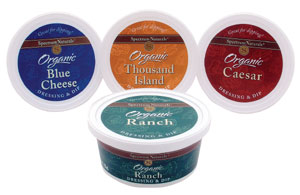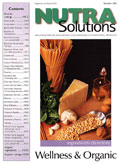
The U.S. Department of Agriculture (USDA) estimates that in the last decade, U.S. organic food retail sales increased 23% annually—five times faster than food sales in general. Nearly 40% of shoppers are reaching for products labeled organic, and the segment's sales are expected to reach more than $11 billion this year. Sales for the entire organic market—not only food and beverages but also health supplements and personal care items—are expected to exceed $32 billion.
What is fueling this accelerated growth in the organic food market? Is it Baby Boomers trying to be healthier and prolong their longevity, or consumers demanding fresher, purer and more close-to-nature foods? Whatever the reasons, as consumers demand more convenience foods made with natural and certified organic ingredients, major food processing companies increasingly are interested in manufacturing organic foods.
The current organic foods market no longer is supplied solely by small, organic farms that produce fruits, vegetables and grains. Instead, it also encompasses bigger farms, better packaging, better distribution and larger food manufacturers who realize that organics are not just for a small consumer niche. A 2001 study by the Food Marketing Institute (FMI) (Washington, D.C.) and Prevention (Emmaus, Pa.) notes that, instead, the target audience is college-graduated Baby Boomers (58%) who live in large cities on the East and West Coasts; Generation Xers (66%) who have environmental concerns and consider organic foods very important; and mature consumers (56%) who purchase organic foods.
The study also reports that, while only one-fourth of Caucasian shoppers place a high priority on organic foods, 37% of African-Americans and 39% of Hispanic shoppers are purchasing organic items. This new recognition of organic purchasers is enticing larger manufacturers to expand their organic offerings.

Multinational food businesses such as ConAgra (Omaha, Neb.), Danone (Allentown, Pa.), General Mills (Minneapolis), Heinz (Pittsburgh), Kellogg (Battle Creek, Mich.), Kraft (Northbrook, Ill.), Nestle (Glendale, Calif.) and Quaker Oats (Chicago) have recognized the importance of this market by entering it with new products or by acquiring or partnering with successful major organic brands such as Stonyfield Farms (Londonderry, N.H.), Morningstar Farms (a division of Kellogg's) and Boca (part of Kraft). From “soups to nuts,” consumers are offered organic products in almost every food category. Organic food products also are available in grocery stores and supermarkets, as well as in specialty stores.
Distribution Points
In 2000, organic foods sales in conventional supermarkets exceeded sales in health food stores and other traditional outlets. This is, in part, because multinational food businesses have wider distribution channels and the ability to rapidly place products into mainstream grocery stores. Large discounters, such as Wal-Mart (Bentonville, Ark.) and Costco (Issaquah, Wash.), also have become more important players. Their organic sales have increased from 1% of total sales in 1999 to 13% in 2000, according to a 2001 report from the Hartman Group (Bellevue, Wash.). In 2000, more than half (53%) of organic food consumers purchased their organic food from supermarkets, 26% at farmers' markets, and 19% in large health/natural food supermarkets—up 13% from the previous year, notes the FMI/Prevention study.Recognizing the trend, grocery store retailers are grouping organic foods in special sections for consumer convenience. While some consumers say they have trouble finding organic products in stores and would like them grouped in one area, others prefer them located next to their conventional counterparts throughout the store. Either way, consumers need to be made aware that the products are organic.
Retailers are creating communities around organic products—emphasizing local connections, cross merchandising them with supplements and other health-related items, offering cooking classes and sampling. With the expected future growth in organic foods, grocery retailers want to capture as much of these sales dollars as possible.
Denny Milnes, a category manager of Hy-Vee Food Stores (West Des Moines, Iowa), has seen a large impact in grocery store marketing as a result of the introduction of new organic products—so much so that Hy-Vee Food Stores is adding the “Hy-Vee Health Market” to all its stores to attract health-conscious consumers. The “Health Market” is a special section dedicated to organic and all-natural food products. It is being placed next to the pharmacy to help emphasize healthful lifestyles. “Having a Health Market section allows us to market organic and all-natural products and provide education to consumers. We see organic foods as a trend that is here to stay,” Milnes said.

New Regulations
Until this year, the industry relied on many different certifying agencies to define and validate organic ingredients. This left consumers confused about the integrity of foods labeled natural, preservative-free and organic. The new USDA National Organic Program (NOP) has created one set of standardized rules. While the organic industry still faces many challenges, the new regulations bring uniformity to the industry and to organic foods on store shelves.(please check the Website Resources at the end of this article for more complete regulation information):
The new regulations mean organic food products are sold under one of four categories:
100% Organic: Contains 100% certified organic ingredients. Product can use the USDA seal (fruits and vegetables).
Organic: The product contains 95% or more organic ingredients. Product can use the USDA seal.
Made with Organic Ingredients: At least 70% of the product is organic. These products cannot use the USDA seal.
Contains Organic Ingredients: Less than 70% of the product is organic. The word “organic” can not appear on the front of the package. Organic ingredients can be listed on the back.

The regulations also provide benefits for producers, handlers and certifiers. Certification means a uniform set of standards for the producers and handlers, consistency among certifiers and fewer fraudulent products.
While industry does not consider the regulations perfect, there is agreement that they provide some uniformity.
Some organic producers want more comprehensive regulations that would prohibit non-organic ingredients in processed foods. Others believe the standards must allow some non-organic ingredients so the finished products function more like conventional foods and can readily enter conventional food markets. Consumers have come to expect certain functionality in conventional foods. Organic foods will need to meet these same standards to effectively compete.
Another issue to consider when pursuing a “100% Organic” or “Organic” label is ingredient sourcing. While certified organic acreages are increasing to meet growing demand, the introduction of new organic products may well exceed the organic raw materials available. U.S. organic farmland expanded to more than two million acres in 2000, up from 1.3 million acres in 1997.
Consolidation has created larger organic farms that produce an increasingly larger proportion of organic raw materials. More organic ingredient options will make sourcing easier for manufacturers and decrease costs to consumers.
To most people, organic means “healthier.” Fully 66% of the Hartman Group respondents cited health as a top motivator for purchasing organic foods. Consumers want to buy foods that contribute to their overall health. Organic food advocates do not claim that organically produced foods are more nutritious. Instead, they point out that organic foods lack insecticides, herbicides and fungicides that are toxic and, possibly, cause cancer. Determining whether people eating well-balanced organic food diets are healthier than those eating well-balanced conventional foods is very difficult. At the current levels found in food, there is no evidence that pesticides cause ill health, so it is hard to say that the lack of residue in organic foods makes people healthier.
New Opportunities
Organic foods sales have been stronger than any other “healthy food” sales. Sales have been doubling every three years and are expected to continue to grow at unprecedented rates. In the next few years, consumers will see a whole new organic foods marketplace, with multinational giants like ConAgra, General Mills, Heinz, Kellogg, Kraft, Nestle and Quaker Oats taking the lead in new product introductions. New organic products in nearly every food category rapidly are entering the market. Growth is expected to continue in the double digits, compared with 2% to 3% in the traditional food industry.
Organic foods are expected to reach almost $22 billion in sales in 2010. As organic ingredients become readily available, growth of organic processed foods will develop much faster than in the past. The health of the organic food market looks very bright.
Website Resources
www.ota.com— Organic Trade Associationwww.fmi.organdwww.prevention.com— FMI/Prevention. 2001.
Shopping for health 2001: Reaching out to the whole health consumer
www.hartman-group.com— Hartman Group. 2001. Healthy living:
Organic and natural products organic lifestyle study, Spring
www.usda.gov/nop— USDA. 2002. National Organic Program:
NOP Regulations and Policies

Sidebar: Value-added Organic Ingredients
Formulating organic vegetable soup and need an organic base, or developing organic biscuits and need wheat flour? Or, are you a supplier of organic ingredients?Prepared Foods, in conjunction with its supplement, NutraSolutions, offers the Wellness & Organic Ingredients Directory every December. For more information, go to www.PreparedFoods.com/buyersguide /index.htm.
— Prepared Foods' Editors
Product Development Challenges
Sourcing organic ingredientsCurrently, there is no public source of either approved organic ingredients or their suppliers. Various suppliers may need to be contacted. Finding a primary and secondary supplier may be difficult.
Technical service representatives
As a resource for food scientists developing and reformulating food products, representatives may not fully understand USDA's National Organic Program (NOP) regulations or know if products meet the organic standards. Many organic ingredients are sold through brokers and are not handled by technical service representatives.
Some ingredients may be prohibited
Processing aids and incidental additives (anti-caking agents, anti-foaming agents, antioxidants, dusting agents, etc.) may be prohibited, resulting in a finished product with a shorter shelf-life or reduced functionality, when compared to a similar non-organic product. Consumers expect like products to have similar shelf lives and functionality. Organic food consumers, especially first-time purchasers, may need to be educated on the functionality differences between organic and non-organic products.
Organic co-packers may be difficult to find
Processors will need to change their practices to become organic-certified processors. The new certification regulations for processing facilities may discourage some co-packers from processing organic foods.
Organic standards
National and international organic standards may differ from the new NOP standards. Products that meet the new NOP standards may not meet the organic standards of other countries, other certification agencies or of individual consumers.